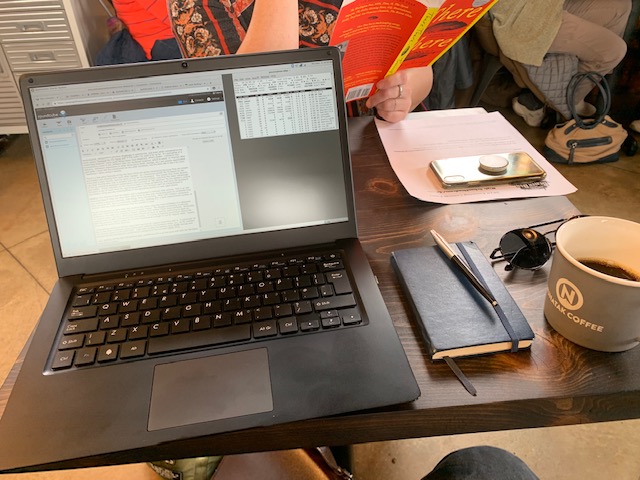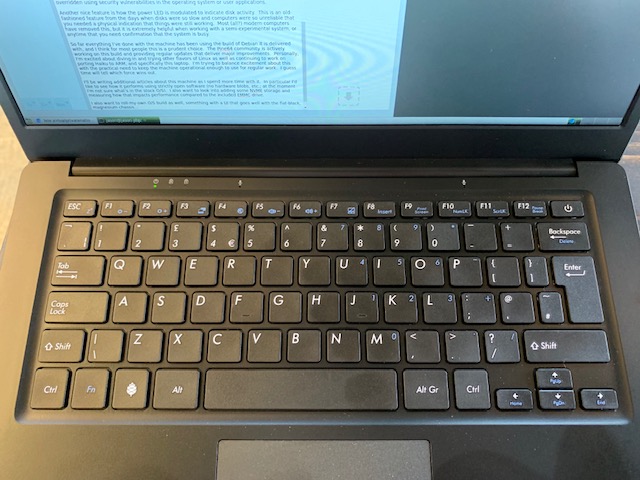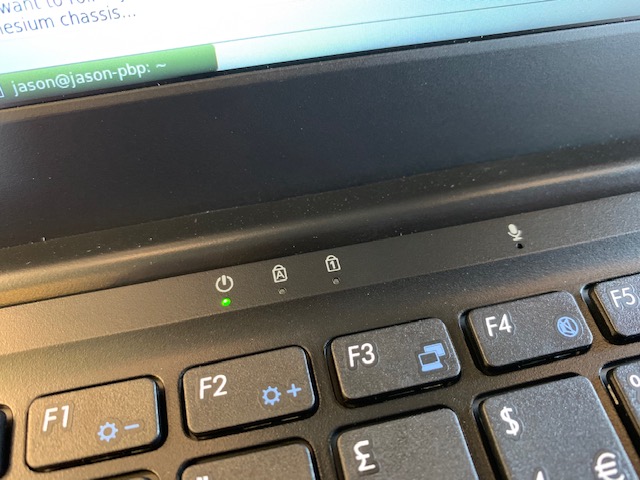My Pinebook Pro arrived a few days ago. Here's my first impressions on this machine.

It's solid. Compared to previous Pinebooks I've owned (the original 14" and the "1080p" 11" ) it's built like a tank, and even compared to the Thinkpads and Macbooks I've owned, it feels solid and substantial. There's no flex in the frame, nor the keyboard, and while I don't want to mar the matte black finish testing it, I bet it could take a few big drops in stride.
The keyboard is another area that is vastly improved over the previous models. It's still not perfect, but I like it better than the Mac keyboards, but not quite as much as the Thinkpad (although it's close). It's no challenger for my favorite keyboard (the Das Keyboard Model S Professional ), but no laptop keyboard comes close to that so it's not really a fair comparison.
Speaking of the keyboard, it's ISO, not ANSI, and I only note that because until it arrived I didn't know the difference. All the Pinebooks I've owned have had slightly unusual keyboard layouts that required some getting used to, and the Pro is no exception. The ISO keyboard is so close to the ANSI layout I'm used to that it's almost harder to adapt to compared to a more unusual layout. On the other hand, if you configure the O/S to use an ANSI layout you can ignore the ISO keyboard for the most part, as long as your touch-typing is up-to-par. I found this out after creating a new account on the machine that used a default keyboard layout and didn't realize the change until I had to look at my fingers to find the caret symbol.

The trackpad, a chronic source of pain for all other Pinebooks I've owned is an improvement, but it's still torturous to use for any pointer-intensive work. The good news is that I think it's at least possible to improve the trackpad via software, especially because the trackpad's firmware itself is open-source. In the meantime it's easy enough to attach an external pointing device, and I've become so accustomed to my trackball that I prefer using something other than a trackpad anyway.
Battery life so far is impressive, but this isn't surprising in comparison to previous Pinebooks. Both the 14" and the 11" I've owned have never wanted for battery capacity and the Pinebook Pro carries on this tradition. I haven't scientifically analyzed the battery life, but so far the battery has outlasted my capacity to work on it, going 4-5 hours easily before throwing warnings about charging the battery. One concern in regard to the battery is that it seems to take a long time to recharge. I haven't measured this carefully, but I've noticed that there's been a couple times that I've went to grab the machine off the charger and the battery wasn't quite full yet. This is using the stock charger, and perhaps faster charge rates are possible with a beefier supply or by using USB-C charging, but either way this is something I want to pay closer attention to.
The display is great. Matte finish and sufficient resolution to display fonts clearly well below the size I'm able to comfortably read anymore. I haven't tested it outdoors yet (we've already had our first snowfall so I don't expect to be spending too much time outside hacking for awhile), but I expect it will perform similarly to other standard LCD displays (too bad I can't retrofit it with a PixelQi!).
Performance, compared to previous Pinebooks is spectacular, and even when compared to my most recent Thinkpad the Pro fairs well in the tasks I've used it for so far. It's somewhat of a mixed bag however, some tasks being faster than expected, others slower. I attribute this inconsistency more to the software than the hardware however, which is easier to improve after delivery. Hardware expansions in other dimensions (RAM, storage, etc.) are greatly appreciated and while I never felt too constrained on the older hardware, the Pro feels like it has a lot more "headroom" when using it heavily.
There's a few other features of the Pro that I think are worth mentioning because they are simple and helpful and missing from most other laptops. As I mentioned earlier the firmware for the track pad is open-source, and the same is true for the keyboard. This means that these devices can have functionality that is isolated from the operating system, and Pine has taken advantage of this by providing keyboard combinations that function as "kill switches" for the laptop's camera and radios. These switches cut the electrical path to these peripherals, and since the keyboard firmware is out of reach from the operating system, this function can't be compromised or overridden using security vulnerabilities in the operating system or user applications.

Another nice feature is how the power LED is modulated to indicate disk activity. This is an old-fashioned feature from the days when disks were so slow and computers were so unreliable that you needed a physical indication that things were still working. Most (all?) modern computers have removed this, but it is extremely helpful when working with a semi-experimental system, or anytime that you need confirmation that the system is busy.
So far everything I've done with the machine has been using the build of Debian it is delivered with, and I think for most people this is a prudent choice. The Pine64 community is actively working on this build and providing regular updates that deliver major improvements. Personally, I'm excited about diving-in and trying other flavors of Linux as well as continuing to work on porting Haiku to ARM, and specifically this laptop. I'm trying to balance excitement about this with the practical need to keep the machine operational enough to use for regular work. I guess time will tell which force wins out.
I'll be writing additional articles about this machine as I spend more time with it. In particular I'd like to see how it performs using strictly open software (no hardware blobs, etc.; at the moment I'm not sure what's in the stock O/S). I also want to look into adding some NVMe storage and measuring how that impacts performance compared to the included eMMC drive.
I also want to roll-my-own O/S build as well, something with a UI that goes well with the flat-black, magnesium chassis...
